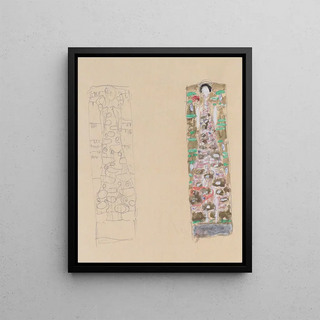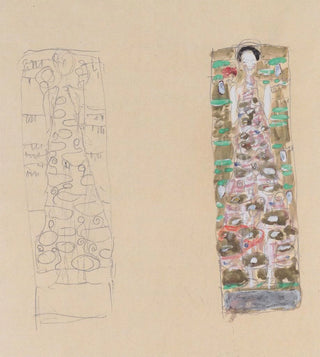Art print | Two models for Otto Wagner's decorative leaf - Gustav Klimt


View from behind

Frame (optional)
In the fascinating world of art, some works transcend time and space, captivating the imagination of art enthusiasts across generations. The art print Deux modèles pour la feuille décorative d'Otto Wagner - Gustav Klimt stands out as an iconic piece of Art Nouveau, a movement that redefined aesthetic standards of its era. This piece, blending elegance and innovation, reflects the interaction between architecture and decorative arts, offering a unique vision of Klimt's creativity. Exploring this work reveals not only a visually appealing aspect but also a reflection on harmony between form and function, an essential characteristic of Otto Wagner's work, the architect behind this collaboration.
Style and uniqueness of the work
The art print Deux modèles pour la feuille décorative d'Otto Wagner - Gustav Klimt is distinguished by its bold style and delicate floral motifs. Klimt, recognized for his use of gold and richly textured compositions, departs here from his most famous themes to explore a more graphic and ornamental dimension. The sinuous lines and organic shapes evoke nature while incorporating geometric elements, creating a harmonious balance that draws the eye. The piece reveals meticulous attention to detail, each motif seeming to tell a story, a tribute to the ephemeral beauty of life. This work perfectly illustrates the spirit of Art Nouveau, which sought to establish a connection between art and craftsmanship while celebrating everyday beauty.
The artist and his influence
Gustav Klimt, a major figure of Art Nouveau, managed to leave his mark on his era through his innovative approach and unique artistic vision. Born in Vienna, he was deeply influenced by the ideas of the Secession movement, which advocated a break with academic conventions. Klimt thus developed a distinctive style, blending sensuality and symbolism, which had a lasting impact on the art world. His collaboration with Otto Wagner, a pioneer of modern architecture, not only enriched his work but also contributed to the evolution of

Matte finish

View from behind

Frame (optional)
In the fascinating world of art, some works transcend time and space, captivating the imagination of art enthusiasts across generations. The art print Deux modèles pour la feuille décorative d'Otto Wagner - Gustav Klimt stands out as an iconic piece of Art Nouveau, a movement that redefined aesthetic standards of its era. This piece, blending elegance and innovation, reflects the interaction between architecture and decorative arts, offering a unique vision of Klimt's creativity. Exploring this work reveals not only a visually appealing aspect but also a reflection on harmony between form and function, an essential characteristic of Otto Wagner's work, the architect behind this collaboration.
Style and uniqueness of the work
The art print Deux modèles pour la feuille décorative d'Otto Wagner - Gustav Klimt is distinguished by its bold style and delicate floral motifs. Klimt, recognized for his use of gold and richly textured compositions, departs here from his most famous themes to explore a more graphic and ornamental dimension. The sinuous lines and organic shapes evoke nature while incorporating geometric elements, creating a harmonious balance that draws the eye. The piece reveals meticulous attention to detail, each motif seeming to tell a story, a tribute to the ephemeral beauty of life. This work perfectly illustrates the spirit of Art Nouveau, which sought to establish a connection between art and craftsmanship while celebrating everyday beauty.
The artist and his influence
Gustav Klimt, a major figure of Art Nouveau, managed to leave his mark on his era through his innovative approach and unique artistic vision. Born in Vienna, he was deeply influenced by the ideas of the Secession movement, which advocated a break with academic conventions. Klimt thus developed a distinctive style, blending sensuality and symbolism, which had a lasting impact on the art world. His collaboration with Otto Wagner, a pioneer of modern architecture, not only enriched his work but also contributed to the evolution of






